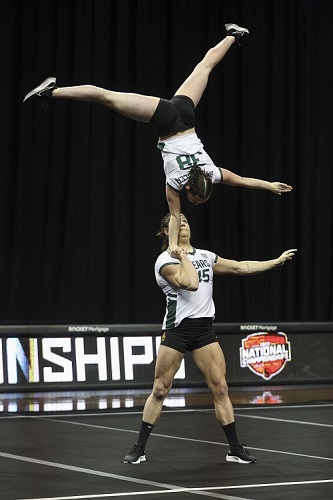Image courtesy of STUNT/USA Cheer
In January, the NCAA added STUNT, a team sport that uses cheer skills but removes the crowd-leading aspect, to its DII list of Emerging Sports for Women. Another team-based program that uses gymnastics skills, Acrobatics & Tumbling, had already made the list for Divisions I, II and III in 2020.
STUNT is a sport that was created in 2010 by USA Cheer, the national governing body for cheerleading. Acrobatics and Tumbling, meanwhile, is organized by the National Collegiate Acrobatics & Tumbling Association (NCATA). It also began in 2010.
And both have ties to larger groups that command respect in the sports event space. Last summer, the International Cheer Union (the world governing body for cheer) received full inclusion from the International Olympic Committee. NCATA, meanwhile, notes that acrobatics & tumbling is a discipline of USA Gymnastics, and news concerning collegiate teams is carried on that organization’s website.
Right now, both sports are currently engaged in making the climb to the requisite number of varsity programs to move forward to the NCAA governance structure for championship consideration. Each offers colleges and universities a way to host a program that satisfies Title IX requirements as well as meeting NCAA standards.

STUNT, whose list of participating schools can be found here, has 51 colleges, according to USA Cheer’s executive, Lauri Harris, who notes that “teams are playing this spring, with a mix of NCAA, NAIA, Junior College and Club programs.”
NCATA, whose list can be found here, also has 51 programs, according to its website. Janell Cook, NCATA’s exec, notes that all programs are currently varsity programs. Approximately 36 are competing.
“We can apply [for championship status] when we have 40 institutions competing,” she adds.
So far, so good. Both sports are well on their way, have good futures and are popular and well liked among their athletes. Beyond that, however, what are the similarities? What are the differences?
Synopsis: In short, both sports use skills and elements found in cheer, minus the crowd-leading aspect. (In this respect, they are similar to all-star cheer programs, which are private gym-based programs that are not affiliated with a school; however, they are both college-centric and team-based sports that are aimed at providing opportunities for female athletes to use their cheerleading background in a competitive format after high school). Neither uses the 2-minute and 30-second time slot for routines seen during cheer competitions.
Program formats for each sport differ, however:
NCATA: Two or three teams may compete at once. Meets are divided into halves, each having three events. The first half consists of Compulsories, Stunt and Pyramid. The second half includes Basket Toss, Tumbling and Team Routine. Some skills performed are predetermined while others must meet certain criteria.
STUNT: Two teams compete head-to-head on the floor at the same time. Game are divided into quarters; Partner Stunts, Pyramids/Tosses, Jumps & Tumbling, and Team Routine. Each quarter has eight available predetermined routines increasing in difficulty level. Teams will play four rounds in each quarter, with the routine for that round being chosen by the team with possession, which alternates. The teams that executes the routine skills best wins the round and the point.
In the fourth quarter, the routines from quarters 1, 2, and 3 are performed one after another, and each round is worth 3 points.
Both sports have a regular season, as well as a post-season play leading up to their respective championships.
But if your next question is when the two sports will merge – well, that is not in the cards. The sports are governed by completely separate organizations, and both want to keep them on their respective paths toward championship status. Why?
- The athlete base is strong enough to support both: As cheer continues to grow (it not only remains in the top-10 list of the NFHS list for student participation nationwide, and those numbers are augmented by countless all-star programs), the pool of athletes also continues to be incredibly strong. Additionally, STUNT and Acrobatics & Tumbling appeal to college students who may have spent time in gymnastics or even competitive dance programs prior to graduation. In short, the two sports have a strong body of athletes from which to pull; in this respect, they are similar to other sports with different disciplines (indoors volleyball vs. beach volleyball, for example) and do not need to compete for athletes;
- Each sport has its own identity: Each NGB has put in extensive time to create a distinctive sport, and wants to retain that sport’s individuality;
- A lot of time has been spent getting each program where it is: Neither sport wants to see the work it has done eliminated; additionally, no school wants to see its efforts to achieve a championship removed, vacated, forfeited or even marked with an asterisk.
In other words, there’s more to it than simply trying to do a mash-up of two sports with distinct goals and governance principles.
“We both want to continue to grow,” says Cook.
“We are both two different great sports, both recognized individually, Acro from USA Gymnastics and STUNT from USA Cheer,” says Harris.

